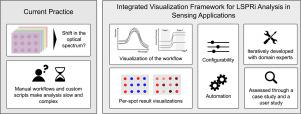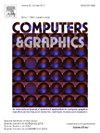传感应用中局部表面等离子体共振成像的可视化框架
IF 2.8
4区 计算机科学
Q2 COMPUTER SCIENCE, SOFTWARE ENGINEERING
引用次数: 0
摘要
lspr !(lspr!)是临床诊断和环境监测中检测各种类型分子的有力工具。在此基础上,lspri!(lspri!)提供空间分辨传感,并已成为一个活跃的研究领域,科学界的兴趣日益浓厚。但是,分析lspri!数据仍然很复杂,需要用户配置模型,选择分析参数,并解释派生的指标——通常是跨不连接的工具或自定义脚本。我们提供了一个可视化框架,在整个分析过程中支持用户。它自动化了分析的某些方面,同时仍然允许用户配置模型和参数,并可视化中间和最终结果,以促进比较和解释。我们的系统是通过迭代设计过程与领域专家密切合作开发的,并通过与使用lspri的科学家面谈进行评估!在研究中。它有可能简化lspri!数据分析,使研究人员能够更有效地探索、比较和改进他们的建模选择。本文章由计算机程序翻译,如有差异,请以英文原文为准。

A visualization framework for localized surface plasmon resonance imaging in sensing applications
lspr! (lspr!) is a powerful tool in clinical diagnostics and environmental monitoring for detecting various types of molecules. Building on this foundation, lspri! (lspri!) offers spatially-resolved sensing and has emerged as an active area of research with growing interest within the scientific community. However, analyzing lspri! data remains complex, requiring users to configure models, choose analysis parameters, and interpret derived metrics—often across disconnected tools or custom scripts. We present a visualization framework that supports users throughout the full analysis process. It automates certain aspects of the analysis while still allowing users to configure models and parameters and visualizes both intermediate and final results to facilitate comparison and interpretation. Our system was developed in close collaboration with domain experts through an iterative design process and evaluated through interviews with scientists using lspri! in their research. It has the potential to streamline lspri! data analysis, enabling researchers to explore, compare, and refine their modeling choices more efficiently.
求助全文
通过发布文献求助,成功后即可免费获取论文全文。
去求助
来源期刊

Computers & Graphics-Uk
工程技术-计算机:软件工程
CiteScore
5.30
自引率
12.00%
发文量
173
审稿时长
38 days
期刊介绍:
Computers & Graphics is dedicated to disseminate information on research and applications of computer graphics (CG) techniques. The journal encourages articles on:
1. Research and applications of interactive computer graphics. We are particularly interested in novel interaction techniques and applications of CG to problem domains.
2. State-of-the-art papers on late-breaking, cutting-edge research on CG.
3. Information on innovative uses of graphics principles and technologies.
4. Tutorial papers on both teaching CG principles and innovative uses of CG in education.
 求助内容:
求助内容: 应助结果提醒方式:
应助结果提醒方式:


